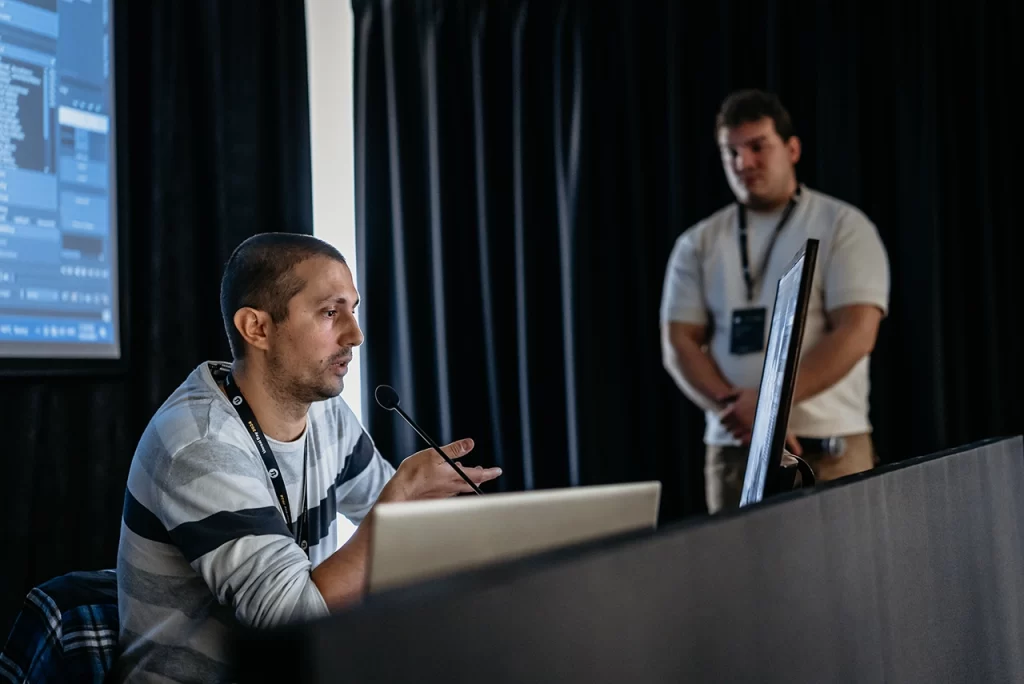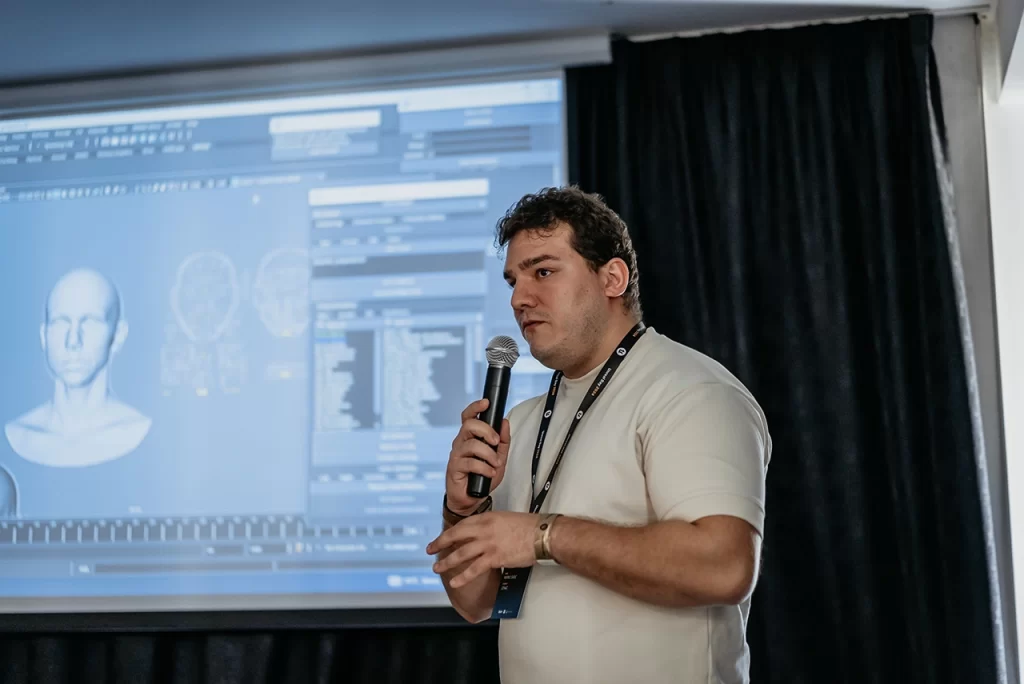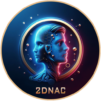
In today’s world of digital character creation, realism is key. From high-end games to cinematic experiences, the ability to create lifelike digital doubles that mimic not only the appearance but also the subtle movements of a real person is essential. At 2DNAC, we specialize in creating custom digital doubles with a focus on precise facial blendshape movements that bring characters to life.
On October 24th, we have presented a 2-hour masterclass in Belgrade focused on how to create these custom blendshapes, covering everything from facial movement to topology for digital double characters. This blog post will give you a sneak peek into the process, tools, and techniques behind this intricate work—showcasing not only how we do it but also how you, as an artist, could achieve similar results.


Why Custom Tools Are Key to Our Pipeline
At 2DNAC, we use mostly custom tools for our character creation pipeline, which significantly streamlines the process of building high-fidelity digital doubles. While many of the steps—like blendshape creation and rigging—are tasks that skilled artists could handle on their own, our custom pipeline makes it easier, faster, and more cost-effective to create high-quality digital doubles for AAA productions.
Our pipeline automates several stages, reducing the complexity of manual work, and allows artists to focus on creative tasks rather than the technical details. The result? Characters with superior facial animation quality that are ready for production in record time.
What Are Facial Blendshapes, and Why Are They Important?
Facial blendshapes are a key component in creating realistic digital doubles. They allow us to manipulate the mesh of a character’s face to simulate expressions, speech, and emotions in a way that mirrors natural human movement. From subtle eyebrow raises to complex lip movements, blendshapes make digital characters look and feel more lifelike.
At 2DNAC, we’ve developed a unique process for crafting custom facial blendshapes that not only match the actor’s original expressions but also enhance them for digital environments. Whether it’s for games or cinematics, our blendshapes allow for highly detailed, dynamic facial performances that bring characters to life.
Our Process for Creating Custom Facial Blendshapes
When it comes to creating a custom digital double, especially focusing on facial movements, there are several stages in our pipeline that ensure each blendshape is as precise as possible. Here’s a glimpse into our process:
- Detailed Facial Scanning: Our process begins with high-quality scan data. Using advanced photogrammetry techniques, we capture over 40 distinct facial expressions of the actor. This scan data serves as the foundation for the facial blendshapes, providing us with a baseline for muscle movement and skin deformation.
- Sculpting in ZBrush: Once the scan data is acquired, we use ZBrush to sculpt the facial blendshapes. Each blendshape is carefully crafted to match the exact facial movements of the actor. We focus on fine-tuning the muscle structures around the eyes, mouth, and cheeks to ensure that every smile, frown, or eyebrow raise looks natural.
- Topology and Rigging in Maya: Creating smooth and accurate facial animations requires a clean, well-structured mesh. Using Maya, we optimize the facial topology to ensure that the blendshapes transition seamlessly during animation. This involves refining edge loops around high-deformation areas, such as the mouth and eyes, so that expressions flow smoothly without breaking the mesh.
- Blendshape Integration in Unreal Engine: The final step is integrating these custom blendshapes into Unreal Engine, where they are animated in real time. Our facial animation rig allows for full control over each blendshape, making it possible to blend and mix expressions dynamically. This is particularly useful for real-time performances, such as virtual production or interactive experiences.
- Wrap3D for Facial Wrap To ensure that the facial movements are realistic, we use Wrap3D for retargeting blendshapes and ensuring that each expression is correctly mapped across different characters.

Why Custom Tools Matter for Faster, High-Fidelity Characters
One of the main advantages of 2DNAC’s pipeline is our ability to streamline the creation of these complex facial blendshapes. While artists can create blendshapes manually using tools like ZBrush and Maya, our custom tools automate and optimize key parts of the process. This allows us to deliver high-fidelity digital doubles faster and more efficiently, which is critical for AAA productions where both quality and speed are non-negotiable.
Our custom tools ensure that every facial movement is captured and replicated in the most efficient way possible, while also reducing the margin for error. This means fewer revisions, less manual tweaking, and ultimately, a cheaper process without compromising quality. It also means that what would normally take weeks to complete can be done in a matter of days with our optimized workflow.
The Power of Custom Blendshapes for Digital Doubles
Our work with digital doubles isn’t just about creating a 3D model; it’s about capturing the essence of the actor. With custom blendshapes, we can replicate the subtle quirks that make each face unique, from a crooked smile to a raised eyebrow. These nuances are what elevate a digital double from a simple 3D asset to a living, breathing character.
Tools of the Trade: ZBrush, Maya, Unreal Engine, and More
At 2DNAC, we rely on industry-leading tools alongside our custom solutions to bring our characters to life:
- ZBrush: Our primary sculpting tool, used to craft detailed blendshapes and facial features.
- Maya: Essential for rigging, animation, and optimizing facial topology.
- Unreal Engine: Where the final animation comes together, allowing for real-time performance and interaction.
- Wrap3D: Used to transfer blendshapes across characters and ensure that facial features adapt accurately.
- Photoshop: For texture creation and touch-ups, ensuring the skin, eyes, and other facial features look natural during animations.
Conclusion: Bringing Digital Doubles to Life, Faster and Easier
Facial blendshapes are an essential tool for creating digital doubles that don’t just look like real people but move like them too. At 2DNAC, our custom tools and optimized pipeline make it easier, faster, and more affordable to create these high-fidelity characters for AAA productions.
Whether you have attended our masterclass or simply exploring the world of digital doubles, we hope this post gives you a clear understanding of the importance of facial movement and topology in creating lifelike characters. For more insights, follow our work online as we continue to push the boundaries of digital character creation.
